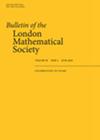求助PDF
{"title":"偏奇正交特征和插值舒尔多项式","authors":"Naihuan Jing, Zhijun Li, Xinyu Pan, Danxia Wang, Chang Ye","doi":"10.1112/blms.70109","DOIUrl":null,"url":null,"abstract":"<p>We introduce two vertex operators to realize skew odd orthogonal characters <span></span><math>\n <semantics>\n <mrow>\n <mi>s</mi>\n <msub>\n <mi>o</mi>\n <mrow>\n <mi>λ</mi>\n <mo>/</mo>\n <mi>μ</mi>\n </mrow>\n </msub>\n <mrow>\n <mo>(</mo>\n <msup>\n <mi>x</mi>\n <mo>±</mo>\n </msup>\n <mo>)</mo>\n </mrow>\n </mrow>\n <annotation>$so_{\\lambda /\\mu }(\\mathbf {x}^{\\pm })$</annotation>\n </semantics></math> and derive the Cauchy identity for the skew characters via the Toeplitz–Hankel-type determinant as an analog of Schur functions. The method also gives new proofs of the Jacobi–Trudi identity and Gelfand–Tsetlin patterns for <span></span><math>\n <semantics>\n <mrow>\n <mi>s</mi>\n <msub>\n <mi>o</mi>\n <mrow>\n <mi>λ</mi>\n <mo>/</mo>\n <mi>μ</mi>\n </mrow>\n </msub>\n <mrow>\n <mo>(</mo>\n <msup>\n <mi>x</mi>\n <mo>±</mo>\n </msup>\n <mo>)</mo>\n </mrow>\n </mrow>\n <annotation>$so_{\\lambda /\\mu }(\\mathbf {x}^{\\pm })$</annotation>\n </semantics></math>. Moreover, combining the vertex operators related to characters of types <span></span><math>\n <semantics>\n <mrow>\n <mi>C</mi>\n <mo>,</mo>\n <mi>D</mi>\n </mrow>\n <annotation>$C,D$</annotation>\n </semantics></math> (Baker, <i>J. Phys. A</i>. <b>29</b>(12) (1996), 3099–3117; Jing and Nie, <i>Ann. Combin</i>. <b>19</b> (2015), 427–442) and the new vertex operators related to <span></span><math>\n <semantics>\n <mi>B</mi>\n <annotation>$B$</annotation>\n </semantics></math>-type characters, we obtain three families of symmetric polynomials that interpolate among characters of <span></span><math>\n <semantics>\n <mrow>\n <msub>\n <mi>SO</mi>\n <mrow>\n <mn>2</mn>\n <mi>n</mi>\n <mo>+</mo>\n <mn>1</mn>\n </mrow>\n </msub>\n <mrow>\n <mo>(</mo>\n <mi>C</mi>\n <mo>)</mo>\n </mrow>\n </mrow>\n <annotation>$\\mathrm{SO}_{2n+1}(\\mathbb {C})$</annotation>\n </semantics></math>, <span></span><math>\n <semantics>\n <mrow>\n <msub>\n <mi>SO</mi>\n <mrow>\n <mn>2</mn>\n <mi>n</mi>\n </mrow>\n </msub>\n <mrow>\n <mo>(</mo>\n <mi>C</mi>\n <mo>)</mo>\n </mrow>\n </mrow>\n <annotation>$\\mathrm{SO}_{2n}(\\mathbb {C})$</annotation>\n </semantics></math>, and <span></span><math>\n <semantics>\n <mrow>\n <msub>\n <mi>Sp</mi>\n <mrow>\n <mn>2</mn>\n <mi>n</mi>\n </mrow>\n </msub>\n <mrow>\n <mo>(</mo>\n <mi>C</mi>\n <mo>)</mo>\n </mrow>\n </mrow>\n <annotation>$\\mathrm{Sp}_{2n}(\\mathbb {C})$</annotation>\n </semantics></math>. Their transition formulae are also explicitly given among symplectic, orthogonal, and odd orthogonal characters.</p>","PeriodicalId":55298,"journal":{"name":"Bulletin of the London Mathematical Society","volume":"57 8","pages":"2509-2530"},"PeriodicalIF":0.9000,"publicationDate":"2025-06-02","publicationTypes":"Journal Article","fieldsOfStudy":null,"isOpenAccess":false,"openAccessPdf":"","citationCount":"0","resultStr":"{\"title\":\"Skew odd orthogonal characters and interpolating Schur polynomials\",\"authors\":\"Naihuan Jing, Zhijun Li, Xinyu Pan, Danxia Wang, Chang Ye\",\"doi\":\"10.1112/blms.70109\",\"DOIUrl\":null,\"url\":null,\"abstract\":\"<p>We introduce two vertex operators to realize skew odd orthogonal characters <span></span><math>\\n <semantics>\\n <mrow>\\n <mi>s</mi>\\n <msub>\\n <mi>o</mi>\\n <mrow>\\n <mi>λ</mi>\\n <mo>/</mo>\\n <mi>μ</mi>\\n </mrow>\\n </msub>\\n <mrow>\\n <mo>(</mo>\\n <msup>\\n <mi>x</mi>\\n <mo>±</mo>\\n </msup>\\n <mo>)</mo>\\n </mrow>\\n </mrow>\\n <annotation>$so_{\\\\lambda /\\\\mu }(\\\\mathbf {x}^{\\\\pm })$</annotation>\\n </semantics></math> and derive the Cauchy identity for the skew characters via the Toeplitz–Hankel-type determinant as an analog of Schur functions. The method also gives new proofs of the Jacobi–Trudi identity and Gelfand–Tsetlin patterns for <span></span><math>\\n <semantics>\\n <mrow>\\n <mi>s</mi>\\n <msub>\\n <mi>o</mi>\\n <mrow>\\n <mi>λ</mi>\\n <mo>/</mo>\\n <mi>μ</mi>\\n </mrow>\\n </msub>\\n <mrow>\\n <mo>(</mo>\\n <msup>\\n <mi>x</mi>\\n <mo>±</mo>\\n </msup>\\n <mo>)</mo>\\n </mrow>\\n </mrow>\\n <annotation>$so_{\\\\lambda /\\\\mu }(\\\\mathbf {x}^{\\\\pm })$</annotation>\\n </semantics></math>. Moreover, combining the vertex operators related to characters of types <span></span><math>\\n <semantics>\\n <mrow>\\n <mi>C</mi>\\n <mo>,</mo>\\n <mi>D</mi>\\n </mrow>\\n <annotation>$C,D$</annotation>\\n </semantics></math> (Baker, <i>J. Phys. A</i>. <b>29</b>(12) (1996), 3099–3117; Jing and Nie, <i>Ann. Combin</i>. <b>19</b> (2015), 427–442) and the new vertex operators related to <span></span><math>\\n <semantics>\\n <mi>B</mi>\\n <annotation>$B$</annotation>\\n </semantics></math>-type characters, we obtain three families of symmetric polynomials that interpolate among characters of <span></span><math>\\n <semantics>\\n <mrow>\\n <msub>\\n <mi>SO</mi>\\n <mrow>\\n <mn>2</mn>\\n <mi>n</mi>\\n <mo>+</mo>\\n <mn>1</mn>\\n </mrow>\\n </msub>\\n <mrow>\\n <mo>(</mo>\\n <mi>C</mi>\\n <mo>)</mo>\\n </mrow>\\n </mrow>\\n <annotation>$\\\\mathrm{SO}_{2n+1}(\\\\mathbb {C})$</annotation>\\n </semantics></math>, <span></span><math>\\n <semantics>\\n <mrow>\\n <msub>\\n <mi>SO</mi>\\n <mrow>\\n <mn>2</mn>\\n <mi>n</mi>\\n </mrow>\\n </msub>\\n <mrow>\\n <mo>(</mo>\\n <mi>C</mi>\\n <mo>)</mo>\\n </mrow>\\n </mrow>\\n <annotation>$\\\\mathrm{SO}_{2n}(\\\\mathbb {C})$</annotation>\\n </semantics></math>, and <span></span><math>\\n <semantics>\\n <mrow>\\n <msub>\\n <mi>Sp</mi>\\n <mrow>\\n <mn>2</mn>\\n <mi>n</mi>\\n </mrow>\\n </msub>\\n <mrow>\\n <mo>(</mo>\\n <mi>C</mi>\\n <mo>)</mo>\\n </mrow>\\n </mrow>\\n <annotation>$\\\\mathrm{Sp}_{2n}(\\\\mathbb {C})$</annotation>\\n </semantics></math>. Their transition formulae are also explicitly given among symplectic, orthogonal, and odd orthogonal characters.</p>\",\"PeriodicalId\":55298,\"journal\":{\"name\":\"Bulletin of the London Mathematical Society\",\"volume\":\"57 8\",\"pages\":\"2509-2530\"},\"PeriodicalIF\":0.9000,\"publicationDate\":\"2025-06-02\",\"publicationTypes\":\"Journal Article\",\"fieldsOfStudy\":null,\"isOpenAccess\":false,\"openAccessPdf\":\"\",\"citationCount\":\"0\",\"resultStr\":null,\"platform\":\"Semanticscholar\",\"paperid\":null,\"PeriodicalName\":\"Bulletin of the London Mathematical Society\",\"FirstCategoryId\":\"100\",\"ListUrlMain\":\"https://londmathsoc.onlinelibrary.wiley.com/doi/10.1112/blms.70109\",\"RegionNum\":3,\"RegionCategory\":\"数学\",\"ArticlePicture\":[],\"TitleCN\":null,\"AbstractTextCN\":null,\"PMCID\":null,\"EPubDate\":\"\",\"PubModel\":\"\",\"JCR\":\"Q2\",\"JCRName\":\"MATHEMATICS\",\"Score\":null,\"Total\":0}","platform":"Semanticscholar","paperid":null,"PeriodicalName":"Bulletin of the London Mathematical Society","FirstCategoryId":"100","ListUrlMain":"https://londmathsoc.onlinelibrary.wiley.com/doi/10.1112/blms.70109","RegionNum":3,"RegionCategory":"数学","ArticlePicture":[],"TitleCN":null,"AbstractTextCN":null,"PMCID":null,"EPubDate":"","PubModel":"","JCR":"Q2","JCRName":"MATHEMATICS","Score":null,"Total":0}
引用次数: 0
引用
批量引用




 求助内容:
求助内容: 应助结果提醒方式:
应助结果提醒方式:


